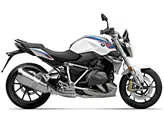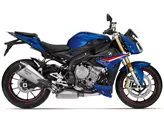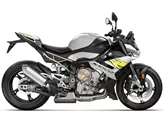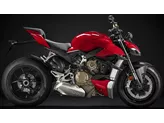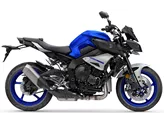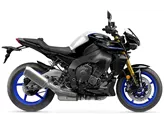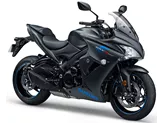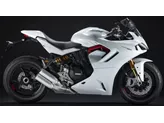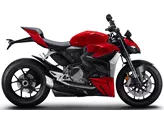BMW S 1000 R 2016 vs. Yamaha MT-10 SP 2019

BMW S 1000 R 2016

Yamaha MT-10 SP 2019
Overview - BMW S 1000 R 2016 vs Yamaha MT-10 SP 2019
The BMW S 1000 R 2016 and the Yamaha MT-10 SP 2019 are both powerful naked bikes with similar engine specifications. They both have an inline 4-cylinder engine with a displacement of around 1000cc and produce 160 horsepower. The BMW has a torque of 112 Nm, while the Yamaha has a torque of 111 Nm.
In terms of suspension, both bikes feature an upside-down telescopic fork at the front and a swing arm with a monoshock at the rear. The frames of both bikes are made of aluminum, but the BMW has a twin tube frame, while the Yamaha has a Deltabox frame.
When it comes to braking, both bikes are equipped with double disk brakes at the front. The BMW also has double disk brakes at the rear, while the Yamaha's rear brake type is not specified. The BMW has advanced rider assistance systems, including dynamic suspension, which enhances the bike's performance.

BMW S 1000 R 2016
In terms of dimensions and weights, both bikes have the same front and rear tire widths and diameters. The BMW has a slightly longer wheelbase of 1439 mm compared to the Yamaha's 1400 mm. The seat height of the BMW is 814 mm, while the Yamaha has a slightly higher seat height of 825 mm. The BMW weighs 207 kg with ABS, while the Yamaha weighs 210 kg with ABS. Both bikes have a fuel tank capacity of around 17 liters.
Now, let's discuss the strengths and weaknesses of each bike. The BMW S 1000 R 2016 is praised for its powerful and well-controllable engine, as well as its powerful braking system. It also offers a comfortable seating position, which is important for long rides.
On the other hand, the Yamaha MT-10 SP 2019 has an unconventional sound that adds to its appeal. It also boasts a high-quality chassis and suspension, providing a smooth and comfortable ride. The bike offers pleasant wind protection and surprisingly comfortable seating position, making it suitable for longer rides. Additionally, the engine response of the Yamaha is highly regarded.

Yamaha MT-10 SP 2019
However, the BMW S 1000 R 2016 does have some weaknesses. It offers optional extras that are expensive, making it less accessible for some riders. The chassis of the BMW is also considered to be hard, which may affect the overall comfort of the ride.
Similarly, the Yamaha MT-10 SP 2019 has a few weaknesses. It lacks traction control with a gyro sensor, which could be beneficial for serious racetrack use. The shift assistant of the Yamaha is not flawless, which can be a drawback for some riders. Additionally, the Yamaha is priced higher compared to its competitors.
In conclusion, both the BMW S 1000 R 2016 and the Yamaha MT-10 SP 2019 are powerful naked bikes with similar engine specifications. They have their own strengths and weaknesses, and the choice between the two ultimately depends on the rider's preferences and priorities.
Technical Specifications BMW S 1000 R 2016 compared to Yamaha MT-10 SP 2019
Pros and Cons in comparison
Pros and Cons in comparison
BMW S 1000 R 2016

With the BMW S 1000 R, you notice both the close relationship to the S 1000 RR superbike and the endeavour to equip the machine with a high degree of comfort for country roads and everyday use. Accordingly, the 1000cc four-cylinder power unit is brute and yet easily controllable, and the seating position is correspondingly sporty and comfortable. The fact that the S 1000 R is one of the most affordable power naked bikes is surprising and very pleasing, although one must not get hold of the list of optional extras - because thanks to the many irresistible features, it will certainly be more expensive.
Yamaha MT-10 SP 2019

The Yamaha MT-10 SP inspires with a high degree of perfection combined with a truckload of emotion. Rarely do Japanese manufacturers succeed in penetrating so deeply into the domain of Europeans. The bike rides very nastily when needed, but can also be used quite civilly in city traffic. On top of that, the electronically adjustable Öhlins suspension offers a lot of riding comfort. All in all, an outstanding all-rounder that can do much more than just look bad.
Price Comparison Avarage Market Price BMW S 1000 R vs Yamaha MT-10 SP
There are a few key differences between a BMW S 1000 R 2016 and a Yamaha MT-10 SP 2019. There are the same number of bikes of both models available on the 1000PS.de marketplace, specifically 10. It takes less time to sell a BMW S 1000 R with 69 days compared to 92 days for a Yamaha MT-10 SP. Since model year 2014 1000PS.de editors have written 62 reviews for the BMW S 1000 R and 18 reviews for the Yamaha MT-10 SP since model year 2017. The first review for the BMW S 1000 R was published on 11/3/2013 and now has more than 17,300 views. This compares to more than 28,600 views for the first review on Yamaha MT-10 SP published on 10/4/2016.


